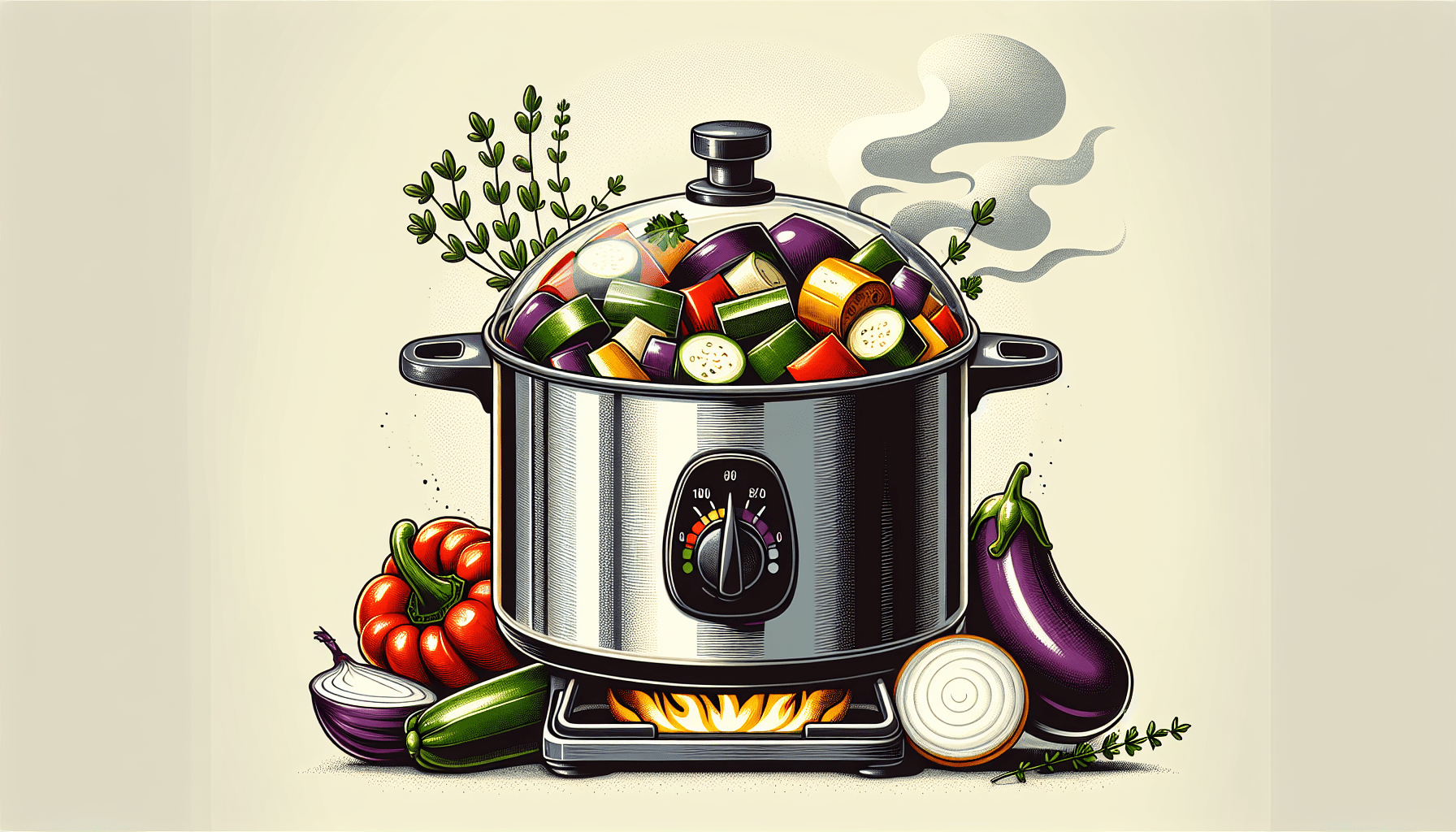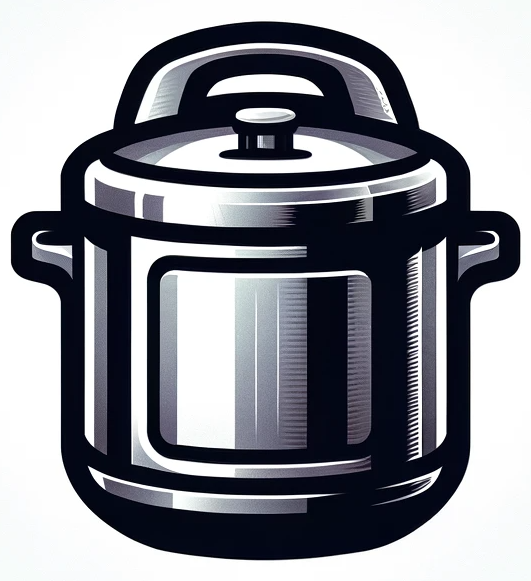Imagine being able to make a delicious and hearty ratatouille in just a fraction of the time it usually takes. With a pressure cooker, you can achieve this feat effortlessly. This article will introduce you to a flavor-packed ratatouille recipe that is specially designed for the convenience of a pressure cooker. So, get ready to impress your friends and family with this delectable dish that will leave them craving for more.
Ingredients
Eggplant
Eggplant is a key ingredient in ratatouille, adding a rich and meaty texture to the dish. Choose eggplants that are firm with shiny skin, and make sure to remove any bitter seeds before cooking.
Zucchini
Zucchini adds a subtle sweetness and a lovely green color to the ratatouille. Look for small to medium-sized zucchinis that are firm and have smooth skin.
Red bell pepper
Red bell peppers bring a vibrant red color and a sweet, slightly tangy flavor to the ratatouille. They also provide a nice crunch. Choose bell peppers that are firm, shiny, and have no wrinkles.
Yellow bell pepper
Yellow bell pepper adds a bright and sunny color to the dish, as well as a slightly sweeter flavor compared to red bell peppers. This ingredient is optional but highly recommended for a more visually appealing and flavorful dish.
Onion
Onions are essential in adding a depth of flavor to the ratatouille. Choose yellow or white onions, and make sure they are firm and free of bruises or blemishes.
Garlic cloves
Garlic cloves add a delicious aromatic element to the dish. Use fresh garlic cloves for the best flavor. Make sure to remove the papery skin before using.
Tomatoes
Tomatoes provide a juicy and tangy base for the ratatouille. Opt for ripe, firm tomatoes with bright red skin. You can use either Roma tomatoes or vine-ripened tomatoes, depending on your preference.
Fresh basil leaves
Fresh basil leaves lend a fragrant and herbaceous note to the ratatouille. Look for leaves that are bright green and free from any wilting or discoloration.
Fresh thyme leaves
Fresh thyme leaves add a subtle earthy flavor and aroma to the ratatouille. Use the leaves without the stems for the best flavor.
Olive oil
Olive oil is an essential ingredient for sautéing the vegetables and enhancing their flavors. Choose a good quality extra virgin olive oil for the best taste.
Salt
Salt is crucial for bringing out the natural flavors of the vegetables and seasoning the dish to perfection. Use kosher or sea salt for the best results.
Pepper
Pepper adds a hint of warmth and spice to the ratatouille. Freshly ground black pepper is recommended for the most flavor.
Preparation
Step 1: Prepare the vegetables
Start by washing and drying all the vegetables. Cut the eggplant, zucchini, and bell peppers into 1-inch cubes. Slice the onion and mince the garlic cloves. Dice the tomatoes, making sure to remove the seeds. Tear the basil leaves into smaller pieces and strip the thyme leaves from the stems.
Step 2: Sauté the vegetables
Heat a tablespoon of olive oil in the pressure cooker over medium heat. Add the onion and garlic, and sauté until they become translucent and fragrant. This will take about 2-3 minutes. Then, add the eggplant, zucchini, red bell pepper, and yellow bell pepper. Sauté the vegetables for another 5 minutes, stirring occasionally until they start to soften.
Step 3: Add tomatoes and herbs
Add the diced tomatoes, basil leaves, and thyme leaves to the pressure cooker. Season with salt and pepper to taste. Stir well to combine all the ingredients and let the mixture cook for another 2-3 minutes to allow the flavors to meld together.
Step 4: Pressure cook the ratatouille
Close the pressure cooker with its lid and lock it securely. Set the pressure cooker to high pressure and cook the ratatouille for about 8-10 minutes. The cooking time may vary depending on the type and brand of pressure cooker you are using. Make sure to follow the manufacturer’s instructions for safe and proper usage.
Step 5: Serve and enjoy
Once the ratatouille is cooked, carefully release the pressure from the cooker according to the manufacturer’s instructions. Open the lid and give it a gentle stir to combine all the flavors. Serve the ratatouille hot as a main dish or a side. It pairs well with crusty bread or rice.
Tips
Choose ripe vegetables
To ensure the best flavor and texture, choose ripe and fresh vegetables. Avoid using overripe or underripe vegetables as they may affect the overall taste and consistency of the dish.
Cut the vegetables evenly
To ensure even cooking, it is important to cut the vegetables into uniform sizes. This allows for a consistent texture and prevents some pieces from becoming overcooked while others remain undercooked.
Adjust the cooking time
The cooking time may vary depending on your pressure cooker’s settings and the size of the vegetable pieces. If you prefer softer vegetables, you can increase the cooking time by a few minutes. On the other hand, if you prefer a crunchier texture, reduce the cooking time slightly.
Add extra flavor with optional ingredients
Feel free to experiment with additional ingredients to enhance the flavor of your ratatouille. Some popular optional ingredients include balsamic vinegar, red pepper flakes for a spicy kick, or even adding chickpeas for added protein and texture.
Serve with crusty bread or rice
Ratatouille is a versatile dish that can be enjoyed on its own or paired with a variety of accompaniments. Serve it with crusty bread to soak up the flavorful juices, or serve it over a bed of fluffy rice for a more substantial meal.

Benefits of Using a Pressure Cooker
Retains nutrients
Cooking ratatouille in a pressure cooker helps to retain the nutrients in the vegetables. The shorter cooking time and the sealed environment prevent excessive loss of vitamins and minerals, compared to traditional cooking methods.
Saves time
Pressure cookers are known for their ability to cook food quickly. By using a pressure cooker to make ratatouille, you can significantly reduce the cooking time compared to simmering the dish on the stovetop.
Enhances flavors
The high pressure and heat in a pressure cooker help to intensify the flavors of the vegetables and herbs. This results in a more flavorful and aromatic ratatouille compared to slow-cooking methods.
Reduces energy consumption
Pressure cookers are energy-efficient appliances. The shorter cooking time means less time spent using your stovetop or oven, resulting in lower energy consumption and reduced utility bills.
FAQs
Can I use canned tomatoes instead of fresh?
Yes, you can substitute fresh tomatoes with canned tomatoes if you prefer. Just make sure to use good quality canned tomatoes without any added seasonings or preservatives. Adjust the seasoning accordingly, as canned tomatoes tend to be more acidic.
Can I skip sautéing the vegetables?
Sautéing the vegetables before pressure cooking helps to bring out their flavors and enhances the overall taste of the ratatouille. While you can skip this step if you’re short on time, it is recommended to sauté the vegetables for the best results.
Can I freeze ratatouille?
Yes, ratatouille can be frozen for later use. Allow it to cool completely before transferring it to airtight containers or freezer bags. Label and date them, then store them in the freezer for up to 3 months. To thaw, simply place in the refrigerator overnight or reheat directly from frozen.
Can I make it in a slow cooker instead?
Yes, you can adapt this recipe for a slow cooker. Follow the steps for preparation and sautéing the vegetables as described, then transfer everything to a slow cooker instead of a pressure cooker. Cook on low heat for 6-8 hours or on high heat for 3-4 hours until the vegetables are tender.
Variations
Ratatouille with balsamic vinegar
To add a tangy twist to your ratatouille, drizzle a tablespoon of balsamic vinegar over the vegetables before pressure cooking. The acidity of the vinegar complements the sweetness of the vegetables and adds a delicious depth of flavor to the dish.
Spicy ratatouille
For those who enjoy a little heat, spice up your ratatouille by adding red pepper flakes or a pinch of cayenne pepper. Adjust the amount according to your preference, and be sure to taste and adjust the seasonings as necessary.
Ratatouille with chickpeas
For a heartier and protein-packed version of ratatouille, add a can of rinsed and drained chickpeas to the vegetables before pressure cooking. The chickpeas add a satisfying texture and make the dish more substantial.
Storage and Reheating
Allow to cool completely before storing
Before refrigerating or freezing the ratatouille, it is important to allow it to cool completely. This helps to prevent condensation and maintain the quality of the dish.
Store in an airtight container in the refrigerator
Transfer the ratatouille to an airtight container or a covered dish before storing it in the refrigerator. Proper storage will help to keep it fresh and safe to consume for up to 4-5 days.
Reheat in a saucepan or microwave
To reheat the ratatouille, simply transfer a portion to a saucepan and heat it gently over medium heat until warmed through. Alternatively, you can microwave it in a microwave-safe dish, stirring occasionally until heated to your desired temperature.
Serve and Enjoy
Garnish with fresh herbs
Before serving, garnish the ratatouille with a sprinkle of fresh basil leaves or thyme leaves. This adds a pop of color and freshness to the dish, elevating its visual appeal.
Serve as a main dish or side
Ratatouille can be enjoyed as a main dish for vegetarians or as a flavorful side dish to accompany meats, poultry, or seafood. It’s a versatile dish that can be served in a variety of ways to suit different preferences and dietary needs.
Conclusion
Ratatouille is a classic French dish that celebrates the vibrant flavors of summer vegetables. By using a pressure cooker, you can conveniently and quickly create a delicious ratatouille with tender vegetables that are bursting with flavor. Whether you serve it as a main dish, a side dish, or even as a light lunch, this pressure cooker ratatouille will surely impress your family and friends. So go ahead, gather your ingredients, follow the step-by-step instructions, and enjoy this hearty and nutritious dish made with love. Bon appétit!


